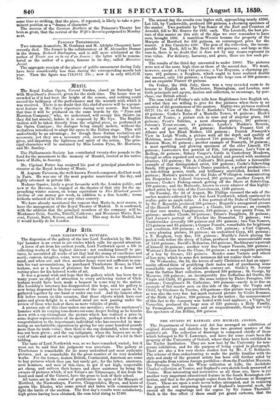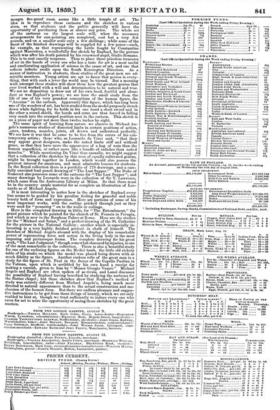THE STUDIES BY RAPHAEL AND MICHAEL ANGELO.
The Department of Science and Art has arranged an exhibition of original drawings and sketches by these two greatest masters of the painter's art. The collection of drawings is composed chiefly of those which belonged to Sir T. Lawrence, and have for some years been the property of the University of Oxford, where they have been exhibited in the Taylor Institution. They are now lent by the University for tem- porary exhibition, and for the purpose of being copied in photograph. There are also a few very choice studies lent by Mr. J. C. Robinson. The scheme of thus endeavouring to make the public familiar with the style and study of the greatest artists has been still further aided by photographs from various foreign portfolios—from the Frankfort Museum, the Florence Gallery, the Wicar collection at Lille, the Archduke Charles' collection at Venice, and Raphael's own sketch-book preserved at Venice. Most interesting and instructive as all these are, there is yet another very important educational feature in the South Kensington col- lection, and that is the photograph copies from the Cartoons at Hampton Court. These are upon a scale never before attempted, and in realizing the grandeur and surpassing beauty of Raphael's immortal work, far exceed all the engravings and the copies by Sir James Thornhill. Such is the fine effect d these small yet grand cartoons, that the meagre fire-proof room seems like it little temple of art. The idea is to reproduce these cartoons and the sketches in various sizes, so that students and the public generally will have the opportunity of purchasing them at almost any price. The whole set of the cartoons on the largest scale will, when the necessary arrangements for sun-printing are completed, cost but a very few pounds, and on a smaller scale only a few shillings ; while some of the finest of the finished drawings will be supplied for a few pence-such, for example, as that representing the battle fought by Constantine against Maxentius, a wonderfully fine sketch by Raphael, for the picture which was after his death painted by his renowned pupil, Giulio Romano. This is to cost exactly tenpence. Thus to place these priceless treasures of art in the hands of every one who has a taste for art is a most useful and ameliorating application of science in the cause of art, and one that reflects infinite credit upon the South Kensington Directors. As a means of instruction to students, these studies of the great men are ad- mirable monitors. Young artists are apt to fancy that genius is every- thing, that with such a lever the world may be turned. But a morning walk amongst these studies will show them how the greatest genius that ever lived worked with a will and determination to be natural and true. We see no disposition to draw out of his own head, fruitful and abun- dant as was Raphael's power; we see here the small study from the life of one of his very grandest conceptions of the human figure, the "Ananias " in the cartoon. Apparently this figure, which has long been one of the wonders of art, has been studied from the model purposely struck down while fighting, for he holds in his one hand a short sword and in the other a round shield, the hands and arms are thus forced in falling very much into the cramped position seen in the cartoon. This sketch is on a piece of paper not more than twelve inches by eight.
The same spirit of learning from nature we observe in Michael An- gelo's numerous studies of dissected limbs in certain positions of action, ',ones, tendons, muscles, joints, all drawn and understood perfectly. We see how it was that he came to be free from the errors of his con- temporary artists; those who, as Leonardo da Vinci said, " that they may appear great designers, make the naked limbs stiff and without grace, so that they have more the appearance of a bag of nuts than the human superficies, or rather more like a bundle of radishes than naked muscles." While mentioning Da Vinci thus casually, we might suggest that a collection of the sketches by this man of equally cultivated genius, might be brought together in London, which would also possess the greatest interest for amateurs, and most admirable lessons for students. In the Royal collection there is a portfolio of 779 drawings, and a care- fully executed lead pencil drawing of "The Last Supper." The Duke of Somerset also possesses some of the cartoons for "The Last Supper "; and many drawings by Leonardo were in the collection of Sir T. Lawrence, which came from the Ambrosian Library at Milan. So that there must be in the country ample material for as complete an illustration of Leo- nardo as of Michael Angelo. It is most interesting to notice how in the sketches of Raphael every line seems to be guided by his peculiar feeling for graceful and noble beauty both of form and expression. Here are portions of some of his most important works, with the outline pricked through just as they were used for "pouncing " on to the walls or ceilings. Here is the completed drawing in little, for "The Entombment," the grand picture which he painted for the church of St. Francis in Perugia, and which is now in the Borghese Palace at Rome. Here are the studies for the "Michael and Satan," and a perfect drawing of the St. Catherine for the picture in the National Gallery ; another which is especially in- teresting is a very highly finished portrait in chalk of himself. The sketches of Michael Angelo abound with the display of his remarkable power of representing force and action in the living body in the most imposing and picturesque forms. The complete drawing for his great work, "The Last Judgment," though somewhat obscured byinjuries, is one of the most remarkable in the collection. There is also a beautiful study for one of the reclining figures on the Medici tomb, the little old rickety table of his studio on which the model was placed being drawn with as much fidelity as the figure. Another curious relic of the great man is a study for the figure of St. Paul in the fresco of the Capella Paolina in the Vatican, upon which is scribbled by his own hand a receipt for making a varnish, given to him by " Messer Giorgio Vasari." Michael Angelo and Raphael are often spoken of as rivals, and Lanai discusses the possibility of Raphael having benefited by studying the cartoons for the Sistine chapel; but these sketches show that Raphael's method of study was entirely different from Michael Angelo's, being much more directed to natural appearances than to the actual construction and me- chanism of the human form. But there are endless pleasure and sugges- tive instructions to be got from these things of beauty, which we are only enabled to hint at, though we trust sufficiently to induce every one who cares for art to seize the opportunity of seeing those sketches by the great masters.



























 Previous page
Previous page